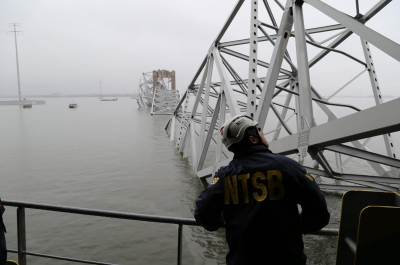(Bloomberg) -- President Barack Obama’s decision to close the door to offshore drilling along the U.S. East Coast — just a year after opening it — inflicts more pain to an oil industry that’s already battered by falling prices and dropping demand.
The move follows a U.S. government crackdown on methane emissions at nearly a million oil and gas wells, new mandates for fracking on public land and Obama’s rejection of the proposed Keystone XL pipeline.
Now, with the Obama administration’s decision to rule out selling drilling rights in Atlantic waters between 2017-2022, oil and gas companies’ U.S. offshore opportunities are largely confined to territory they’ve been plumbing for decades, including Alaska’s Cook Inlet and the Gulf of Mexico, where 10 auctions are planned.
Environmentalists cheered the administration’s about-face on the Atlantic, but industry leaders were furious.
"The decision appeases extremists who seek to stop oil and natural gas production ,which would increase the cost of energy for American consumers and close the door for years to creating new jobs, new investments and boosting energy security,” American Petroleum Institute President Jack Gerard said in an e-mailed statement.
Campaign Impact
The drilling debate could reverberate at the ballot box. It already has become an issue in the contest for the Democratic presidential nomination, with Vermont Senator Bernie Sanders promising to block all offshore oil and gas development and former Secretary of State Hillary Clinton telling environmental activists she was “against drilling off the Atlantic."
While the issue has gotten scant attention in the Republican primary contest, where candidates generally support more domestic oil and gas development, it could be revived by politicians pledging to overturn Obama’s plan.
Oil industry leaders blasted the Atlantic pullback, casting it as kowtowing to environmentalists at the expense of workers whose jobs are tied to domestic energy development. Since oil and gas prices started falling in 2014, energy companies have idled more than 1,000 drilling rigs and cut a quarter million jobs.
Shell’s Exploration
Randall Luthi, a former offshore drilling regulator who heads the National Ocean Industries Association, called the move "mind-boggling."
And Royal Dutch Shell Plc spokesman Curtis Smith said omitting new Atlantic acreage "is short sighted and dismissive of the safe, responsible offshore exploration that has provided jobs, revenue and energy security for the U.S. for more than a half century."
The Interior Department proposal keeps the door open for Arctic lease sales in the Beaufort and Chukchi seas north of Alaska, but low oil prices and Shell’s disappointing results at a critical test well last year have diminished the industry’s enthusiasm for any swift new drilling there.
Current oil prices did not factor into the decision to foreclose selling drilling rights in mid- and south-Atlantic waters, Interior Secretary Sally Jewell told reporters in a conference call. Instead, she said, the calculation was made against a backdrop of market trends, including recent climbs in onshore oil production, and a desire to focus potential sales in areas with the highest resource potential.
Navy Objections
The decision also responded to a groundswell of criticism from residents along the East Coast and Defense Department concerns that drilling rigs and production facilities could impede Navy exercises.
In the Atlantic, "the entire proposed lease area is conflicted," said Abigail Hopper, director of the Bureau of Ocean Energy Management that developed the plan. "There are challenges throughout the area to development there. The scope and scale of the mission in the Atlantic cannot be understated."
The Interior Department will weigh public comments -- including detailed feedback about whether and where to allow drilling in the Arctic -- before finalizing the offshore leasing plan later this year.
Michael Brune, executive director of the Sierra Club, said in an e-mailed statement that Obama had listened "to tens of thousands of citizens up and down the East Coast" by protecting the Atlantic Ocean and safeguarding coastal economies. But more is demanded by international commitments to cut carbon dioxide emissions released when fossil fuels are burned, Brune said, including an end to future drilling in the Arctic and the Gulf of Mexico.
Canadian Visit
The U.S. has already signaled Arctic drilling decisions will be subjected to tough scrutiny. Obama and Canadian Prime Minister Justin Trudeau pledged last week to use science-based planning in the region and weigh "the life-cycle impacts of commercial activities in the Arctic."
“There is no good reason to sell more leases in the Arctic Ocean now, and the government should remove the Chukchi and Beaufort seas from the plan," Michael LeVine, Pacific senior counsel for the conservation group Oceana said by e-mail. But, he said, "it is still valuable to know where the important places in the ocean are. Identifying and protecting important ecological areas is a necessary step toward ensuring the long-term health of the ocean."
Both Congress and the next president could force the government to sell offshore oil and gas leases in the Atlantic and other areas already left out of Interior’s proposal. But any proposal to force Atlantic lease sales is unlikely to advance in the narrowly divided Congress.
And it would take years for the next president to put a new leasing plan in place. Federal laws guide the long process of developing the U.S. government’s offshore leasing program, dictating multiple rounds of environmental analysis and public comment. The process is "laborious" by design, Jewell said.
"A future administration could redo the five-year program and put it back in," Jewell said of the Atlantic. But "it couldn’t be done quickly."





